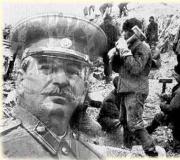Famous cartoonists. "Bah! All the faces are familiar!" Artist Vladimir Mochalov
The outstanding artist, cartoonist and public figure Jean Effel died more than 30 years ago, on October 16, 1982, and his works are still relevant. The creator managed to create incredible masterpieces with laconic plots. Behind the apparent simplicity was hidden deep meaning, not a single social event passed by the artist - he skillfully embodied every little detail in the drawing, causing people to smile and have a positive attitude towards what was happening.
Jean was born in 1908 in Paris and, despite the wishes of his father, who saw his son as a businessman and his successor, Francois Lejeune (Effel's real name) nevertheless became an artist. He lived in a bohemian area of the capital of France, sharing a small room with a poor artist like himself. At that time, he decided to take a pseudonym for himself, because it was fashionable then. The initials F and L in a single reading “made” the surname “Effel”, and the shortest and most common name in the country was chosen as the first name.
This is how Jean Effel appeared.
Around the same time, he met his wife named Margarita and, as a confession, eternal love he promised her that each of his drawings would have a daisy in her honor. Effel began to write his signature with one stroke in a circle, drawing a flower from the letters. The artist thus came up with the idea of making his name a kind of logo. Naturally, such an ardent confession captivated the girl’s heart, and she married the talented Effel. They lived their whole lives in love and harmony, and each artist’s drawing was invariably accompanied by a distinctive daisy….
Effel's cartoons are imbued with positivity. All the characters are simple and laconic, made in a unique manner linear drawing. Simple silhouettes and the lines, heads and faces are always the same. But what is noteworthy is that each element seems to be endowed with a soul. Jean Effel hardly portrayed evil characters, even Lucifer in his book “The Creation of the World” looks like just a naughty dirty trick.
In memory of one of the greatest cartoonists in Europe, we decided to recall his most famous works.
"World creation" is the most famous series Effel's cartoons. They were published as a single book. The main biblical characters are drawn in a humorous manner, and the artist’s own vision of the idea and creation of the Universe is depicted. The Lord is helped by angels and he crafts with them future world and man. The book was published in many countries, performances were made based on it, and operettas were created.
"Simp"— a series of illustrations about life common man, good-natured and simple-minded. No adversity is scary for a hero who knows how to find a way out of any situation. Where another would succumb to anger, this character does not lose heart.
"Wonderful Child"- a series of cartoons about a cute tomboy who cannot imagine his life without small pranks. Often adults don't pay attention to him, but he... just creates his own world!
Small cartoons and comics about animals more than once became the theme for Effel’s drawings. He liked to assign to various animals human traits and statements. The artist did not ignore a single individual on earth. Even snails and oysters are in his cartoons.
Social and national topics became the leitmotif of Jean Effel's work during his activities in the Resistance movement. They published newspapers during the Second World War and sharply condemned the fascists in their drawings. Later, he did not like the policy of the “liberators” - the Americans, who considered themselves the masters of all of Europe. And in peacetime, not one public problem did not pass by the creator's pencil. Its active life position is visible in every cheerful cartoon.








actor shirvindt 







Vladimir Georgievich Mochalov. (born May 21, 1948, Moscow, USSR) - Soviet and Russian caricaturist, graphic artist, painter, author of portrait caricatures and realistic portraits.
He is considered one of the most talented continuers of the traditions of such outstanding masters, like Kukryniksy, B. Efimov, L. Soyfertis, K. Rotov, I. Semenov, V. Goryaev, E. Shukaev. The artist owns more than 10 thousand masterfully executed cartoons and caricatures, drawings and illustrations, marked prestigious awards at Russian and international exhibitions, competitions, biennials.
In his portrait gallery, Vladimir Mochalov depicts famous politicians, figures of art, culture and sports, whom he saw through the prism of irony and the grotesque. He accurately conveys the character’s characteristic grin, characteristic gesture, and gaze. Working not “to order”, the artist paints not glossy, ceremonial, but sharply characteristic, sometimes caustic, revealing portraits.
“Political cartoons are the same masks, the same buffoonery, clowning, this is also a caricature. Fine caricature is one of the facets of our satirical attitude to one politician or another. Politicians always want to save face. They create an image for themselves, enhance their image by all available and inaccessible means. They go out in public and pretend to be a truthful politician in every possible way. And the task of the caricaturist, in my opinion, is to consider in his biography, in his actions, in his actions, things that do not correspond to the image that he creates, and with his own artistic means, using techniques, using a pencil or pen to show, expose, reveal its content,” says the artist.
V. G. Mochalov was born in 1948, in Moscow. Graduated from the Moscow Printing Institute. For about 20 years he was the chief artist of the Krokodil magazine. His sharp cartoons were regularly published in satirical publications in more than thirty countries: Russia, Belgium, the USA, Japan, Turkey, France and other countries.
V. Mochalov - winner of the Grand Prix at International exhibition cartoons in Saint-Esteve (France, 2000), First Prize at International competition cartoons in Surgut (Russia, 2004), special prize and a diploma at the First Moscow International festival“Tradition and Modernity” (Moscow, 2007), medals “Worthy” Russian Academy arts and other awards.
In 1997, Vladimir Mochalov set a world record for drawing caricatures. The Komsomolskaya Pravda newspaper recorded that in one hour Vladimir Mochalov drew 111 cartoons with portrait likeness.
In 2004, V. Mochalov, unexpectedly for many, exhibited about 300 paintings: portraits, landscapes, still lifes. On his canvases - world history twentieth century, primarily in Russia. The artist rewrote his most famous pencil portraits in oil.
V. Mochalov illustrated stories in the magazines “Youth” and “Rural Youth”, books including “Peter Pan”, stories by A. Averchenko, G. Oster and other writers.
The most significant, most vivid portraits depict extraordinary people, but quite familiar to us. The artist discovered something in them that had gone unnoticed by us before, but was very important for characterizing the character’s personality. Most portraits convey not so much the momentary mood as the character of the character, his disposition, sometimes hidden from others. He doesn’t care in what area the person whose portrait he is painting achieved recognition, the main thing is that he is a Personality. Precise, strong drawing that defines the unconditional portrait likeness with a model, the sharp irony of a high-class cartoonist allows you to create grotesque and at the same time psychologically convincing portraits.
The artist paints not only his contemporaries, but also historical figures, one way or another influenced the fate of our country. The creativity of Vladimir Mochalov, modern, lively, original, can make us take a fresh look at the world and the people acting in it.
Personal website of Vladimir Motchalov http://www.motchalov.ru//
Official website of Vladimir Mochalov http://vladimirmotchalov.com/
A caricature is a drawing real person, which distorts or exaggerates some features but preserves the similarity. In other words, caricature is an exaggerated form of portrait art.
Grotesque
Grotesque - a term in art portrait painting, where the face is distorted into an ugly shape. One of best examples works in this style are the series of “grotesque heads” by Leonardo da Vinci. At that time, the artist hardly painted with humor - he simply tried to convey the extremely unpleasant shape of the face. In the 18th century, grotesque drawings were renamed caricatures. In practice, I. Bosch and P. Bruegel the Elder were engaged in grotesque art.
Cartoon
Cartoons first became popular genre visual arts in the 16th and 17th centuries. The drawings were created by satirists to ridicule public figures and politicians are working with moral significance. They are still popular today, and are used in magazines and newspapers to make fun of movie stars, politicians and other celebrities.
Mythological painting
The only thing that has changed is art tools and materials. Initially, cartoonists made drawings using charcoal, pencil or pen using ink. Today, the artist has access to graphics programs on a PC. 
Cartoonists had considerable power over public opinion, thanks to the availability of information even for illiterate people. One of the most famous examples graphics in this style are satirical etchings of Napoleon Bonaparte from British artist James Gillray. He portrayed French Emperor short man in a huge hat. As a result, up to today this topic interests the public.
Caricatures are a populist art form. These are talented figurative drawings, more powerful and effective than most portraits.
Classification
In contemporary painting, caricature is presented in the form of a humorous or satirical drawing on social, personal, everyday, political topics or as illustrations for jokes.
Genre Nude in painting
Artists perform color or monochrome drawings:
- lines and contours,
- strokes.
This genre is divided into humorous, satirical images and an easel caricature with philosophical overtones. The works of caricaturists can be seen not only in painting, but also in any printed products in technology:
- graphics,
- collages,
- illustrations,
- photographs,
- posters,
- advertising,
- installation,
- installations,
- animations,
- architecture,
- performance.
Difference between caricature and comic strip
Comics and popular prints are images fictional characters. Picture stories in this style were first published in the 19th century by the Swiss writer and artist Tepfer in an attempt to create new way transfers literary work. His concept was a harbinger of the advent of animation art and modern comics.
First related stories in painting were intended for publication in daily newspapers, so they were quickly sketched and not distinguished by talent.
Portrait in painting
In contrast, caricatures and satirical caricatures are very painstaking work - colors were manually selected and printed in glossy publications.
Even today this differentiation remains. A color cartoon used to illustrate magazine or newspaper articles is of higher artistic quality than a comic sketch.
With the advent computer equipment, cartoonists expanded the genre by creating complex, comic, and cartoon-like images, especially in the realm of fantasy. 
I have been drawing cartoons for over 20 years, back in college, since I was interested in caricature, I decided thesis make it based on a cartoon. I made several cartoons of the teachers, in particular the one who supervised my thesis. The cartoon had such an effect on him strong impression, that he suggested that I immediately look for another curator. So I had to do my thesis on a different topic.

When I draw a cartoon I relax because I enjoy the work. Anyone who thinks to please the client is not a cartoonist, but a portrait painter. The cartoonist's mission is open to the person then, which he himself is not aware of. Then there will be real delight.

They always ask me: “How did you guess?” Well, this is not even a profession, it is a gift that allows me to see through every person, to look under the mask that he has put on himself.

I transform easily, I love it different costumes, I feel like an artist at work. I know that there is a picky viewer behind me and I try to draw so that the work resembles a circus act.
I never chase quantity, although I always draw quickly, otherwise a person will simply get tired of waiting and will no longer care what you draw there.

Sometimes I like to do grotesque things, although people don’t always recognize themselves in them, but it’s always fun for those who watch the process, standing behind the cartoonist.

After all, what kind of cartoon is it if there is no courage in it? The cartoonist's mission is to show off people, to catch them inner essence which everyone naturally hides.

Although many holiday organizers do not understand this and believe that a cartoonist should not laugh and be serious and God forbid not offend the desired client. However, people gather on holidays to have fun; they can be serious at work too.

Women get it from me too, but I believe that women should not, all as one, resemble famous fashion models. A friendly cartoon depicts the most character traits in a person, so in the picture you can see your real appearance, and not an imaginary one.

However, women are always in the first row to pose for the artist. They are more concerned with their appearance than men and they are always interested in how others perceive their appearance, especially artists. And you shouldn’t think that all females have a complex regarding their appearance. From my own experience, I can confidently say that only a few people suffer from it.

In caricature, the grotesque is what actually distinguishes a portrait from a caricature. You can simply draw bad portraits, as many people actually do, and pass them off as cartoons, but to be honest, the hand doesn’t always obey and not every drawing turns out as desired. Although I rarely like my works, this is generally quite successful, there is also grotesqueness and there seems to be a similarity.
While the guests were working with spoons, I wasted no time. I drew a cartoon of myself. This is more of an image in which I would like to see myself than a real portrait.

Holidays are very often held in beer restaurants. Just don’t think that I’m “that one.” No, I don’t drink, at least when I’m working, and in beer restaurants like Pilsner, where this cartoon was actually drawn, people of very impressive appearance and size are even proud of the width of their faces and the impressive shape of their bellies and the wider you are If you draw a snout for them, the kinder they become because of it.
Most often at weddings, guests are drawn in pairs. I usually first ask everyone to tell me a little about themselves, and then I make a short story out of what I can find out. For example, a man in this cartoon said that he likes to do yoga and that he is a crest. His wife said nothing about herself. I came up with the idea to draw him as a fakir, and her as a geisha with a plate of dumplings.

Cartoons with animals in Lately are becoming more and more popular, as are cartoons and portraits of animals in general.

I drew a cartoon of the politician Govorukhin in pencil and then colored it on the computer.

Cartoon on English actor made with graphite pencil.

Caricature of artists in Yalta. Made in 1996. At that time I was drawing cartoons on the embankment. The cartoon depicts artists Sasha Klechaty and Kaban.

This sketch was made in Anapa in 2000. Still the same Sasha Klechatyi.




